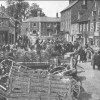In beautiful Dorset countryside surrounded by a grassed and walled churchyard is the delightful Norman church of St. Andrew in the hamlet of Winterborne Tomsom. It owes its present condition to repairs carried out between 1929 and 1932 at the instigation of The Society for the Protection of Ancient Buildings. The architect A.R. Powys, who is buried in the churchyard, supervised the work.
In 1933, the two adjacent parishes of Anderson and Tomson combined under the former name but as time has passed, Anderson became a redundant church and is now in private ownership.
St. Andrew’s church is a single cell Norman structure with an apsidal east-end, the only Norman apse in the county. The walls of the church, made up of many different kinds of Dorset stone and flint have seen quite a lot of rebuilding over the years. The tiled roof, re-laid in 1984, has several courses of stone slates at the bottom. The charming bell-cote was repaired during the 1929-1932 restoration and houses a single bell dated 1668.
The unusually low blocked-off small elliptical window at the west end of the south wall is the result of the walls having been raised by about two-feet in the 16th century. The three large windows in the south wall allow light to flood into the church. Arguably, the square-headed windows are16th century in the view of the Royal Commission on Historical Monuments although the Churches Preservation Trust is of the opinion the windows date from the 17th century.
On entering, the visitor’s attention is straightway drawn to the woodwork presented in the box pews, pulpit, communion rail and screen; note the carved piece cut out in the screen so the preacher need not duck to enter the pulpit. The oak has bleached and paled since it was installed during the early 18th century; the cost was met by the then Archbishop of Canterbury, William Wake, who was born in Dorset at Shapwick.
Whenever he was staying at Shapwick Wake would preach at St. Andrew’s and said he found the calm atmosphere refreshing after the great cathedrals. I wonder what this rural congregation made of finding such an important churchman amongst them and preaching too them.
On the north wall is an inscription tablet erected in 1962 to A. R. Powys and cut by the engraver Reynolds Stone who had a home and workshop at Little Cheney. In the centre aisle is a floor-slab memorial with an inscription to James Ainsworth telling us he died August 12th 1849, aged 10 years, he was the son of James and Marianna Ainsworth who lived at Tomson.
Turn around and you will see over the entrance doorway a gallery with steps leading up to it. This would have seated those who could not afford to rent a family box pew or perhaps it accommodated musicians at some time.
The lime washed plaster emphasises the outward lean of the walls towards the wonderful plastered wagon ceiling.
The 1929-1932 restoration work was paid for by the sale of a collection of Thomas Hardy’s manuscripts held by the Society for the Protection of Ancient Buildings: Hardy had been a member of the society for 47 years.
The Dorset History Centre at Dorchester has the baptism records from 1723 to 1970, Marriages from 1751 to 1968 and Burials from 1769 to 1915.
St. Andrew’s is still a consecrated church but nowadays services are held only at Advent, Whitsun and Harvest Thanksgiving. St. Andrew’s is open daily to the public thanks largely to the excellent work of The Churches Preservation Trust who look after it.



